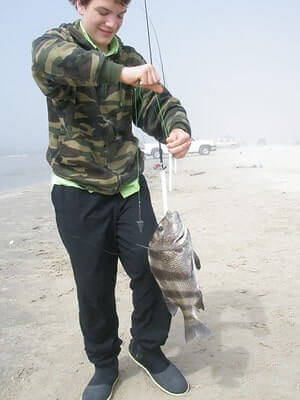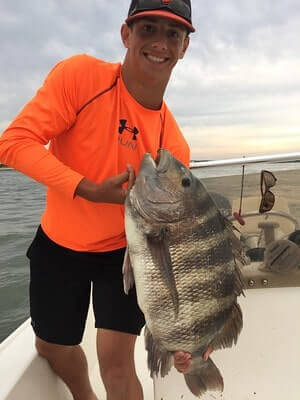Disclosure: We may earn commissions if you purchase products after clicking on a link from our site.
Do you want to learn how to catch sheepshead? Sheepshead are challenging to catch as they are very cautious, are bait thieves, and put up a real fight when caught on the hook. They are fun to catch, tasty, and a favorite for inshore fishermen. Sheepshead is a member of the porgy family and is found along the mid-Atlantic and Gulf coasts. In this article, we will share information about sheepshead and how to catch them.

Table of Contents
How To Catch Sheepshead From Shore
When fishing for sheepshead from the shore, look for artificial reefs, wrecks, rocks, markers, and ledges. Usually, in late winter and spring, you will realize that these areas will have sheepshead. You can cast your line around these structures and target sheepshead. A regular tackle will work for catching sheepshead from the shore. A 6 to 7-foot medium-heavy rod with a 3,000 series reel and a 10# to 15# mono or braided line will work as the right tackle.
When fishing for sheepshead, keep the rod tip low and keep tension in the line while you wait. This will help you feel the sheepshead bite. You will feel a slight change in the weight at the end of the line when the fish starts to move away with the bait. Set the hook, and using sharp circle hooks, lift up the rod to hook it on. Moderate tidal flow is best when fishing sheepshead from the shore as it is more challenging to detect bites and control your rig in swift water.
How To Catch Sheepshead From A Pier or Boat
Use shrimp with a split shot rig to catch sheepshead when you fish from a pier. Set up so that the line is close to the structure. When fishing for sheepshead from a pier, use some equipment to scrape barnacles from structures to attract sheepshead.
Chumming is a good fishing technique to use when you fish for sheepshead from a pier or boat. You can use barnacles that were scraped off structures or other sheepshead bait into the water.

How To Catch Sheepshead In Florida
When fishing for sheepshead in Florida, look for them in grass flats, mangroves, and around oyster bars. Sheepshead prey on barnacles, and if you can find underwater structures that have barnacles on them, you will surely find sheepshead in that area. They are the best places to target sheepshead.
Although barnacles are the favorite prey for sheepshead, clams, fiddler crabs, mussels, mud crabs, hermit crabs, and shrimp can also be used when fishing for sheepshead. Casting, bottom fishing, chumming, still fishing, jigging, and drift fishing are fishing methods you can use when fishing for Sheepshead in Florida.
How To Catch Sheepshead In Texas
When fishing for sheepshead in Texas, look for underwater structures like wrecks, rip-rap, markers, logs, jetties, rock piles, and reefs. Sheepshead is notorious for stealing bait, therefore you have to be alert to nibbles when fishing for sheepshead.
There are many fishing methods that can be used to catch sheepshead such as Chumming, bottom fishing, still fishing, casting, and drift fishing.
Best Sheepshead Baits & Lures
1. Fiddler Crabs
Fiddler crabs are prized bait for sheepshead fishing, thanks to their widespread availability in coastal regions and their irresistible appeal to these finicky feeders. These small crustaceans, named for the oversized claw of the male resembling a fiddle, inhabit muddy or sandy bottoms near marshes, tidal creeks, and estuaries, making them easy prey for foraging sheepshead.
Anglers often collect fiddler crabs by hand or using small nets, targeting areas where they burrow in the mud or hide among marsh grasses during low tide. Once hooked onto the fishing line, mangrove crabs, fiddler crabs present a natural and enticing offering for sheepshead, with their delicate movements and scent attracting the attention of these opportunistic feeders. Whether fished on a bottom rig, sheepshead jigs, knocker rig, jig head, or fiddler crab-specific rigs, these crustaceans are a preferred bait choice for anglers seeking to entice sheepshead into biting.
2. Oysters
Oysters are not commonly used as bait for sheepshead fishing, primarily because they are not typically considered a primary food source for them. Sheepshead is more inclined to feed on crustaceans, mollusks, and small fish rather than oysters.
While sheepshead may occasionally be found near oyster beds, they are usually targeting the small crustaceans and other invertebrates that live among the shells rather than the oysters themselves. Therefore, anglers tend to opt for baits such as fiddler crabs, shrimp, clams, and sand fleas when targeting sheepshead, as these baits more closely mimic their natural diet and are more effective in enticing bites.

3. Barnacles
Barnacles, though not commonly used, can serve as an effective bait for sheepshead fishing under certain circumstances. Sheepshead are known to feed on various crustaceans and mollusks, and barnacles are part of their natural diet.
When targeting sheepshead in areas where barnacles are abundant, such as on dock pilings, bridge pilings, rocks, or other submerged structures, using barnacles as bait can be successful. Anglers can collect barnacles by scraping them off these structures and then using them as bait by hooking them onto their fishing rigs.
However, since barnacles are not as commonly used as other baits like fiddler crabs, small crabs, or shrimp, anglers may need to experiment with different presentation methods to entice sheepshead bites effectively.
4. Clams
Clams are a popular and effective bait choice for sheepshead fishing, particularly in coastal areas where sheepshead frequent rocky structures, jetties, and dock pilings. These shellfish are readily available in many areas and are known to attract sheepshead due to their strong scent and natural appeal.
Anglers typically use fresh or live clams, although frozen ones can also work well. To prepare clams for bait, anglers can shuck them and then use the meat as bait, either threading it onto hooks or securing it with bait thread.
Alternatively, anglers can leave the clam in its shell and attach it to the hook, allowing the sheepshead to extract the meat. Clams offer a durable and enticing option for targeting sheepshead, making them a favorite among anglers pursuing these prized inshore gamefish.

5. Sand Fleas
Sand fleas, also known as mole crabs or sand crabs, are a natural and highly effective bait for sheepshead fishing, especially in coastal areas with sandy bottoms. These small crustaceans are abundant along many shorelines, where they burrow into the sand near the water’s edge.
Sheepshead is particularly fond of sand fleas due to their high protein content and natural availability. Anglers can collect sand fleas by hand or using a sand flea rake, targeting areas where they are known to congregate in the sand.
To use sand fleas as bait, anglers typically thread them onto hooks or impale them through the body to ensure they stay securely attached. Sand fleas emit a strong scent that attracts sheepshead, making them an excellent choice for anglers targeting these elusive and hard-fighting fish along coastal waters.
6. Shrimp
Shrimp are a popular and effective bait for sheepshead fishing, prized for their natural scent and attractive appearance to these finicky feeders. Sheepshead are known for their strong preference for crustaceans, and shrimp rank high on their list of preferred prey.
Anglers often use live or fresh dead shrimp as bait, either purchased from bait shops or caught using cast nets or shrimp traps. When using shrimp as bait for sheepshead, anglers typically thread them onto hooks or skewer them through the body to ensure they stay securely attached.
Shrimp emit a strong odor that can attract sheepshead from a distance, making them an excellent choice for anglers targeting these challenging fish in a variety of coastal environments.

7. Jigs
Jigs are versatile lures widely used by anglers targeting sheepshead, particularly in areas with structures like docks, piers, and rocky outcrops where sheepshead congregate. These lures come in various sizes and colors, mimicking the appearance of small crustaceans and marine creatures that sheepshead feed on.
Anglers often opt for jigs with a weighted head to help them sink quickly to the bottom, where sheepshead typically forage. When fishing with jigs for sheepshead, anglers employ a slow, methodical retrieval technique, bouncing the jig along the bottom to imitate the movement of natural prey. Jigs can be effective year-round for sheepshead, making them a popular choice among anglers looking to entice these elusive and hard-fighting fish.

Sheepshead Fishing Tips
1. The best way to catch sheepshead is to look for them around any underwater structure that has barnacles on it.
2. Sheepshead can be found in grass flats, mangroves, oyster bars, artificial reefs, rocks, marker posts, posts, sunken structures, seawalls, bridges, piers, and mangrove roots.

3. Use 1/0 hook size when fishing for sheepshead.
4. You can use lures to catch sheepshead.

5. A medium-stout 6 to 7-foot rod and reel with a 15 to 20-pound braided line will work well for catching sheepshead.
6. When you are setting up the bait on the hook, break off the shrimp’s head, thread the hook through the tail, hide the hook, and use a short leader.

7. Always keep your line tight and check your bait with a very slight pull.
8. If you feel a tap or the line move slightly, that indicates a fish is on the line.

9. When you hook a sheepshead, keep your rod tip up and do not allow it to take out enough line to wrap you up.
10. Always position yourself so that the bait is close to the structure.

11. Always cut your bait into small portions as sheepshead have very small mouths.
12. Sheepshead can also be found offshore and under docks in about three feet of water.

13. When you feel several taps on your line, it is usually too late as the sheepshead has sucked in the bait.
14. Use a #2-sized J hook a small piece of shrimp and a light 8 to 10-pound fluorocarbon leader.

15. You don’t need a particular tackle to catch sheepshead.
16. The Carolina rig is a popular bottom fishing rig used by anglers to catch sheepshead.
17. Don’t dip the rod as you are attempting to set the hook. You will lose it doing that.

The Bottom Line
Sheepshead is a popular fish for anglers as it is fun to catch and a tasty fish. They are known to be very cautious and bait thieves. You can find sheepshead in the mid-Atlantic up to the Gulf Coast. They put up a serious fight when on the hook and are schooling fish. Sheepshead steal baits and you must be careful when fishing for them.
In this article, we share knowledge and information to help you learn how to catch sheepshead. If you are also interested in learning how to catch fish like mackerel, black drum, pampano, Atlantic spadefish, and spotted seatrout, then read how to catch mackerel, how to catch pompano, black drum fishing tips, how to catch Atlantic spadefish, and how to catch spotted seatrout.